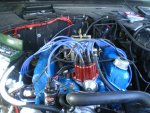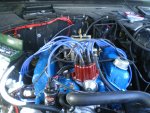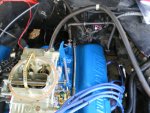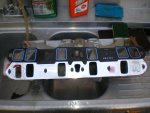wilcom
Member
Just replaced the intake manifold gasket. Had a problem with one I replaced first and didnt seat right...drove it and the temp went up to about 270 deg or so and I shut it down. Checked the oil and found water in it. Towed home and replaced the intake manifold gasket again. Started up and got setam out of the left exhaust (I have dual exhaust). Replace the intake gasket again and got water out the right side not the left. Replaced it again and got water pressure spraying water out the overflow but no water out the exhaust or in the crank.
Here are things done;
Have a new radiator cap..I worked fing through all gasket replacemnts execpt the last one with water spraying out the overflow within 30 seconds after starting. 12-14 lb version.
First set of gaskets were edlebrock with gaskasinch applied per specs and torqued to specs. started up and got steam out of right exhaust. Pulled plugs on that side and found water in cylinder but still firing.
Second were Felpro and done same as above. Started up and got steam out of left side of exhaust. Pulled plugs on that side and got water on one plug but still firing.
Thrid set was Felpro special type, top of the line $40. Started up and got water squirting out of the overflow withing 60 second.
All gaskets were installed per specs, caulked around the water jacket inlets etc.
Torqued to specs with a torqure wrench.
Removed both heads and had them magnafluxed and the surface checked.....no cracks or problems.
Visually checked cylinders when heads were off and didnt see any cracks in cylindders or head surface.
I cant believe I cracked the block when running it the first time, but maybe. The fact that each time I put a intake gasket on it, it does something different has got me guessing. I figure that if there is pressure getting into the water system it has to be coming from the exhaust since that is a pumping pressure and everything on the manifold is a vaccume.
Ok guys.....who has the answer?? <_<
Here are things done;
Have a new radiator cap..I worked fing through all gasket replacemnts execpt the last one with water spraying out the overflow within 30 seconds after starting. 12-14 lb version.
First set of gaskets were edlebrock with gaskasinch applied per specs and torqued to specs. started up and got steam out of right exhaust. Pulled plugs on that side and found water in cylinder but still firing.
Second were Felpro and done same as above. Started up and got steam out of left side of exhaust. Pulled plugs on that side and got water on one plug but still firing.
Thrid set was Felpro special type, top of the line $40. Started up and got water squirting out of the overflow withing 60 second.
All gaskets were installed per specs, caulked around the water jacket inlets etc.
Torqued to specs with a torqure wrench.
Removed both heads and had them magnafluxed and the surface checked.....no cracks or problems.
Visually checked cylinders when heads were off and didnt see any cracks in cylindders or head surface.
I cant believe I cracked the block when running it the first time, but maybe. The fact that each time I put a intake gasket on it, it does something different has got me guessing. I figure that if there is pressure getting into the water system it has to be coming from the exhaust since that is a pumping pressure and everything on the manifold is a vaccume.
Ok guys.....who has the answer?? <_<




